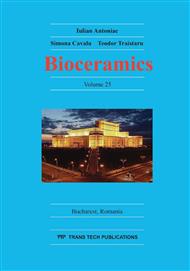[1]
Barrett-Connor, E., 1995. The economic and human costs of osteoporotic fracture. Am. J. Med. A 2, 3S–8.
Google Scholar
[2]
Melton III LJ. How many women have osteoporosis now? J Bone Miner Res 1995; 10: 175–7.
DOI: 10.1002/jbmr.5650100202
Google Scholar
[3]
Ira P. Scott DL, O'neill TW, Pritchard C, Woolf AD, Davis MJ. Quality of life, morbidity, and mortality after low trauma hip fractures in men. Ann Rheum Dis (2005).
Google Scholar
[4]
White B. L, Fisher W.D., Laurin C.A. Rate of mortality for elderly patients after fracture of the hip in the 1980's. J of Bone and Joint Surgery. VOL 69-A, NO. 9, (1987).
Google Scholar
[5]
Steen Jensen,J. Mortality after Hip Fractures. ActaOrthop. Scandinavica, 50: 161-167, (1979).
Google Scholar
[6]
Gordon P.C. The probability of death following a fracture of the hip. Canadian Med. Asson. J., 105: 47-62, (1971).
Google Scholar
[7]
Keene GS, Parker MJ, Pryor GA. Mortality and morbidity after hip fractures. BMJ 1993; 307: 1248–50.
DOI: 10.1136/bmj.307.6914.1248
Google Scholar
[8]
Resch H, Gollob E, Kudlacek S, Pietschmann P. Osteoporosis in the man. Wien Med Wochenschr 2001; 151: 457–63.
Google Scholar
[9]
Cummings SR, Rubin SM, Black D. The future of hip fractures in the United States. Numbers, costs, and potential effects of postmenopausal estrogen. ClinOrthopRelat Res 1990: 163–6.
DOI: 10.1097/00003086-199003000-00024
Google Scholar
[10]
Elffors L. Are osteoporotic fractures due to osteoporosis? Impacts of a frailty pandemic in an aging world. Aging (Milano) 1998; 10: 191– 204.
DOI: 10.1007/bf03339653
Google Scholar
[11]
Ray WA, Taylor JA, Meador KG, et al. Arandomized trial of a consultation service to reduce falls in nursing homes. JAMA 1997; 278: 557–62.
DOI: 10.1001/jama.1997.03550070049037
Google Scholar
[12]
Johnell O. The socioeconomic burden of fractures: today and in the 21st century. Am J Med 1997; 103: 20S–5S.
Google Scholar
[13]
Stevens JA, Olson S. Reducing falls and resulting hip fractures among older women. Centers for Disease Control and Prevention. MMWR, Medical and Mortality Weekly Report. Ref Type: Report. 49 (RR02), 1-12. 31-3-(2000).
DOI: 10.1067/mhc.2000.109232
Google Scholar
[14]
Wehren LE, Magaziner J. Hip fracture: risk factors and outcomes. CurrOsteoporos Rep 2003; 1: 78–85.
DOI: 10.1007/s11914-003-0013-8
Google Scholar
[15]
T. Nymark. Short Time-Frame from the first to the Second Hip Fractures in the Funen Country Hip Fracture Study. Osteoporos. Int 17: 1353-1357.
DOI: 10.1007/s00198-006-0125-y
Google Scholar
[16]
Melton L.J. Hip Fracture Recurrence a Population Based Study. Clinical Orthopedics and Related Research. 167: 131-8 July (1981).
Google Scholar
[17]
Klotzbuecher M.C. Patients with Prior Fractures Have an Increased Risk of Future Fractures: A Summary of the Literature and Statistical Synthesis. J Of Bone & Mineral Research. Vol 15, N 4, (2000).
DOI: 10.1359/jbmr.2000.15.4.721
Google Scholar
[18]
Schroder, Henrik M, Occurrence and Incidence of the Second Hip Fracture. Clinical Orthopedics and Related Research. 289: 166-169 April, (1993).
Google Scholar
[19]
Wolinsky FD, Fitzgerald JF, Stump TE. The effect of hip fracture on mortality, hospitalization, and functional status: a prospect study. Am J Public Health. 1997; 87: 398-403.
DOI: 10.2105/ajph.87.3.398
Google Scholar
[20]
Johnell O, Nilsson BE. Hip fracture and accident disposition. ActaOrthop Scand. 1985; 56: 302-304.
DOI: 10.3109/17453678508993019
Google Scholar
[21]
Bonar SK, Tinetti ME, Speechley M, Cooney LM. Factors associated with short-versus long-term skilled nursing facility placement among community-living hip fracture patients. J Am Geriatr Soc. 1990; 38: 1139-1144.
DOI: 10.1111/j.1532-5415.1990.tb01378.x
Google Scholar
[22]
Parker J. M. Cost Benefit Analysis of Hip Fracture Treatment. J Bone Joint Surg (Br) 1992; 74-B : 261-4.
Google Scholar
[23]
Beckmanna J., Ferguson S.J. , Gebauer M., Luering C.,. Gasser B, Heini P. E Femoroplasty – augmentation of the proximal femur with composite bone cement - feasibility, biomechanical properties and osteosynthesis potential. Medical Engineering & Physics 29 (2007).
DOI: 10.1016/j.medengphy.2006.08.006
Google Scholar
[24]
Heini P. F., Torsten F., Fankhauser C., Gasser B., Ganz R. Femoroplasty-augmentation of mechanical properties in the osteoporotic proximal femur: a biomechanical investigation of PMMA reinforcement in cadaver bones. Clinical biomechanics. 19 (2004).
DOI: 10.1016/j.clinbiomech.2004.01.014
Google Scholar
[25]
M Zlowodzki, O Ayieni, BA Petrisor, M Bhandari, Femoral Neck Shortening After Fracture Fixation with Multiple Cancellous Screws: Incidence and Effect on Function, J Trauma 2008; 64: 163-169.
DOI: 10.1097/01.ta.0000241143.71274.63
Google Scholar


